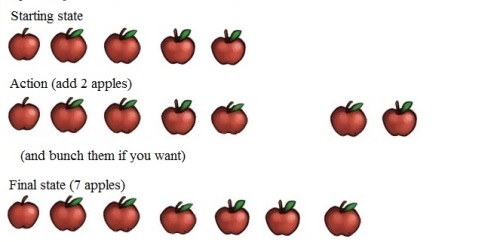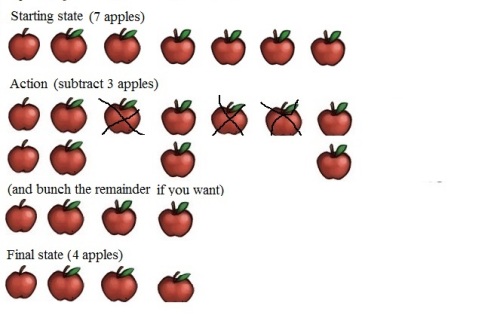Addition
I had 5 apples, and then my brother gave m 2 more apples.
I now have 7 apples.
The process is

Without the pictures:
Starting state (5 apples)
Action (add 2 apples)(and bunch them up !)
Final state (7 apples)
With a single sentence or equation, with the result
Start with 5, add 2, and resulting state is 7
Or the equation with apples
Start with 5 apples, add 2 more apples, and result is 7 apples
Subtraction
I have 7 apples now, and then my brother takes 3 of them away.
I end up with 4 apples .
The process is
Without the pictures:
Starting state (7 apples)
Action (subtract 3 apples)
Final state (4 apples)
With a single sentence or equation, and the result
Start with 7, subtract 3, and resulting state is 4
Or the equation with apples
Start with 7 apples, subtract 3 apples, and result is 4 apples
Both of these equations are read from left to right
— – – – – – – – – – – – – – – – – – – – – – – – – – – – – – – – – – – – – – – – – – – – – — –
Counting and adding.
If I start with 1 and then add 1 I get 2. This doesn’t seem to be a problem at all.
If I start with 2 and then add 1 I get 3. This doesn’t seem to be too big a problem.
If I start with 5 and then add 3 I get 8. This starts to get interesting because starting with 2 and adding 5 has exactly the same final state.
It is all to do with counting.
If I count a pile of bricks and there are ten of them I can jumble the bricks around and count them again. I will still have ten of them. The count is “how many” and nothing else.
Consequently the rearrangement has no counting effect, and so any collection of numbers with plus signs and a total of ten can be rearranged, to give the same total of ten.
For example:
start 2, add 3, add 4, add 1 is the same total as start 2, add 4, add 1, add 3 (result ten)
We can also swap the start number and the add number with an example:
start 3, add 5 is start 4, add 4 and then start 5, add 3. Same total.
And finally, with add we can combine two adds to get add 3, add 2 = add 5
Counting and subtracting.
The apple example:
Starting state (7 apples)
Action (subtract 3 apples)
Final state (4 apples)
The starting state, or start number, is 7
The action is subtract 3
and the final state is 4
— – – – – – – – – – – – – – – – – – – – – – – – – – – – – – – – – – – – – – – – – – – – – — –
Subtracting several numbers.
Have a look at the following:
9 and −2 and −4
The final state is 3, but so is 9 and −4 and −2
Consequently the two subtractions can be swapped.
It’s even better than this: The adds and the subtracts can be put in any order, with the same final state.
Try
start with 9, add 2, subtract 3, subtract 5, add 4, subtract 2 (final state 5)
or rearranged
start with 9, add 2, add 4, subtract 3, subtract 5, subtract 2 (final state 5)
— – – – – – – – – – – – – – – – – – – – – – – – – – – – – – – – – – – – – – – – – – – – – — –
Properties of operations – a critique
Operations and Algebraic Thinking, CCSS grade 1 (italics)
Represent and solve problems involving addition and subtraction.
1. ………
2. ………Understand and apply properties of operations and the relationship
between addition and subtraction.
3. Apply properties of operations as strategies to add and subtract.
Examples:
If 8 + 3 = 11 is known, then 3 + 8 = 11 is also known. (Commutative property of
addition.) To add 2 + 6 + 4, the second two numbers can be added to make
a ten, so 2 + 6 + 4 = 2 + 10 = 12. (Associative property of addition.)
In mathematics there are numerous algebraic structures each consisting of a set of elements equipped with an operation that combines any two elements to form a third element. (Wikipedia, adapted, 19th century math)
So we can find an example of this where any two elements in the set of natural numbers can be combined with “+”, with the usual interpretation. (7 + 4 = 11).
More specifically we can use the “commutative property” of addition, a feature of the natural number system, to tell us that 7 + 4 equals 4 + 7 , for example.
BUT take a look at the above example, with different numbers:
7 − 6 + 4
Swap 4 and 6
7 − 4+ 6
So we have to avoid the negative operator.
The conclusion is that the commutative rule applies only when all the operators are plus operators.
Now what are we going to make of this ?????????
Table 3. The properties of operations. Here a, b and c stand for arbitrary numbers in a given number system. The properties of operations apply to the rational number system, the real number system, and the complex number system. (CCSS)
Commutative property of addition is a+ b = b + a
This is a definition. It states that “a complicated name” is what we know already, and can actually prove by counting. So it is a complete waste of time for K-7 or further.
Not only that, but the actions add 3 and subtract 4 are the original 17th and 18th century statements, and are proper algebra.
